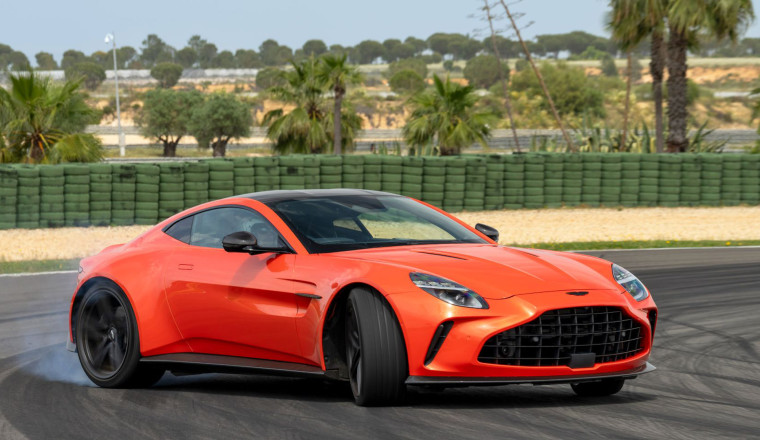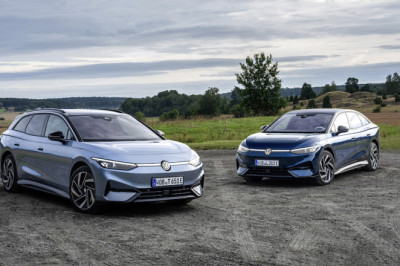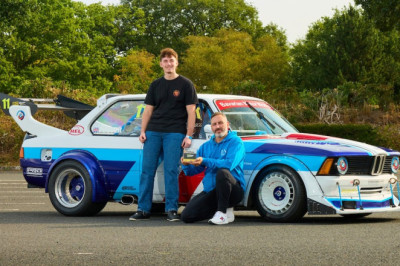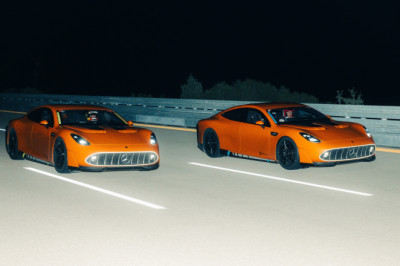
Supercars are the preserve of the lucky few – yet we can all dream. Exotic and expensive, they deliver the ultimate in performance and driving excitement, alongside an unbeatable sense of occasion.
The best supercars of 2025 include some familiar names, such as Aston Martin, Ferrari and McLaren, but there’s also room for two extreme versions of the Porsche 911. All are currently available to buy – if you have the means and, in some cases, a place on the waiting list – and all will make you fall in love with driving again. Even the Monday morning commute seems brighter in a supercar.
Time is running out to buy a rumbling V8 or orchestral V12, so here is how we recommend you live the supercar dream in 2025. Our choices are presented in alphabetical order.
You could buy a DB12 on looks alone, but there is substance behind the considerable style. Beneath that long bonnet lurks a 680hp twin-turbo V8; good for 0-62mph in 3.3 seconds and a top speed of 202mph. Adaptive dampers, a rear e-differential and bespoke Michelin tyres also help this suave super-GT keep its cool on a twisty road. Inside, a long-overdue new touchscreen brings infotainment into the modern era.
Sportier than a Bentley Continental GT and more comfortable than most mid-engined alternatives, the DB12 plays to Aston Martin’s traditional strengths. Prefer the breeze in your bouffant? Try the gorgeous DB12 Volante convertible instead.
We said: ‘The AMG-derived V8 is a fitting foil for the chassis, feeling muscular in the mid-range, then filling its lungs with a cultured snarl. While it isn’t as immersive or downright decadent as Aston Martin’s old-school V12 engine (not coming to this car, sadly), it monsters this road with awe-inspiring ease, serving up relentless acceleration as the eight-speed auto ’box blams through the ratios.’
Read our Aston Martin DB12 review
When the current Aston Martin Vantage was originally launched in 2018, a 510hp twin-turbocharged 4.0-litre V8 placed it towards the upper end of the sports car category. However, a substantial facelift for 2025 gave the Vantage a fresh look and a 30 percent boost in power.
With a turbocharged V8 that now mustered 665hp, the Vantage had become a bona fide supercar. Both the coupe and Vantage Roadster (pictured) also featured a wider track, stiffer chassis and Bilstein dampers, which transformed how they drove. The forthcoming Vantage S promises to take things further still.
We said: ‘It isn’t perfect, of course. The Vantage’s ride feels firm even on smooth Spanish roads and its 325-section tires rumble relentlessly at speed. Then again, if you want a long-striding GT, the Aston Martin DB12 already answers that brief brilliantly. Unlike its bigger brother, the Vantage never totally relaxes. It’s alert, feisty and up on its toes – and it will keep you on your toes, too. It’s an unequivocal and unapologetic supercar. Job done.’
Read our review of the Aston Martin Vantage
Eight hundred and thirty horsepower sounds an insane amount for Ferrari’s ‘entry-level’ supercar. Then again, in a world of 2,000hp electric hypercars, perhaps such head-scrambling numbers are becoming the norm. The 296 GTB and its drop-top GTS sibling (pictured) combine a high-revving 3.0-litre turbocharged V6 with a plug-in hybrid system. Driving the rear wheels only, the result is 0-62mph in 2.9 seconds and a 205mph maximum, along with 15.5 miles of zero-emissions electric range.
The 296 is so accomplished – and so damn fast – it makes the pricier SF90 Stradale look somewhat redundant. So save yourself £125,000 and buy this one instead. There, you didn’t expect cool-headed consumer advice in a Ferrari review, did you? If you simply must have more performance, though, the 868hp 296 Speciale is now waiting in the wings.
We said: ‘Beyond the sound and the fury, the 296 is joyous at any speed. Its steering is lucid and precise, its electronic dampers seem to breathe with the road and the whole car feels progressive and keenly balanced. Underneath, an arsenal of electronic wizardry is analysing every split-second of your progress, but the combined effect is reassuringly analogue. And far more manageable than 830hp has any right to be.’
Read our Ferrari 296 GTS review
It bows out imminently, but the Lamborghini Huracan certainly didn’t grow old gracefully. Indeed, this ‘junior’ supercar only became more outrageous and exhilarating. The track-focused STO (pictured) is perhaps our favourite derivative. A Huracan turned up to 11, with lightweight carbon panels and aggressive aero – not to mention a ferocious 640hp V10 – it feels like a road-legal version of the Super Trofeo racer.
At the opposite end of the spectrum, we also loved the Huracan Sterrato, a beefed-up supercar capable of blasting across rough terrain. Its chunky tyres and lifted suspension are surprisingly well suited to British B-roads, too. The Huracan’s replacement – the 920hp Temerario – will swap its naturally aspirated V10 for a turbocharged, hybridised V8. So maybe the time is tight to experience one of the world’s great engines.
We said: ‘A voracious hunger for revs sees you chasing the 8,500rpm redline whenever possible, grinning like a lunatic as it flings you into the middle-distance. Searing throttle response is also combined with perhaps the best twin-clutch gearbox of all. Driving the Huracan back-to-back with an Aventador SVJ, the contrast with the latter car’s clunky automated manual is acute.’
Read our Lamborghini Huracan STO review
Not even Lamborghini’s flagship supercar can escape the need to embrace electrification. Successor to the long-serving Aventador, the Revuelto combines a naturally aspirated V12 with a plug-in hybrid system. It means that rather than resorting to downsizing or forced induction, the mid-engined Lamborghini continues to fire on all cylinders.
Adding three electric motors to proceedings results in a wild 1,015hp and 0-62mph in just 2.5 seconds. The Revuelto can also reach a top speed of 217mph, and cover up to six miles moving silently on battery power alone. Its dramatic ‘space ship’ styling features Lamborghini’s trademark scissor doors.
We said: ‘If outright speed is what matters, you may as well buy a Tesla. Like every mid-engined V12 Lamborghini since the Miura – which arguably invented the modern supercar in 1966 – the Revuelto stimulates all of your senses. From its shock-and-awe styling, to its thunderous soundtrack, to its nuanced steering and handling, it transforms even the most mundane journey into an event.’
Read our review of Lamborghini Revuelto
The MC20 was the car that heralded Maserati’s comeback – and it was right on target. With a high-tech turbocharged V6 and a carbon fibre tub, it has the Lamborghini Huracan and McLaren Artura squarely in its sights. Yet this elegant, almost understated Italian also has a softer side, blurring the lines between supercar and super-GT.
A fully electric ‘Folgore’ version of the MC20 has now been abandoned. However, the 630hp of this car – capable of 0-62mph in 2.9 seconds and 202mph – seems quite sufficient. Maserati will release an updated version of its mid-engined supercar this year, branded the MCPura, but it keeps all of the best bits of the MC20 intact.
We said: ‘Like the child of 2004’s outrageous Maserati MC12 – itself an evolution of the Ferrari Enzo – the MC20 looks fabulous in the flesh. Its low, pointy nose flows elegantly into a domed cockpit flanked by hungry air intakes. An F40-style Lexan rear window shows off the low-mounted engine, with Trident-shaped vents to help expel heat. The MC20 Cielo convertible might be the prettiest supercar on sale.’
The Artura represented a hard reset for McLaren Automotive: the young company’s first completely new powertrain since the MP4-12C of 2011. Its plug-in hybrid system offers a future-proofed 18.6 miles of electric range, plus a combined 680hp once the 3.0-litre twin-turbo V6 joins the party. Zero to 62mph takes 3.0 seconds and top speed is 205mph.
Almost everything else about the Artura is new, too – including the carbon fibre chassis, rear e-differential and touchscreen tech. It’s a terrific ‘real world’ supercar (if such a thing exists) and a stong foundation for McLaren’s next decade, whatever that may bring. The Artura Spider is the no-compromise convertible version.
We said: ‘The Artura defaults to Electric mode on start-up, allowing you to glide away in near-silence – quite a contrast to the showy theatrics of most supercars. The 95hp e-motor offers ample oomph for urban driving and will stretch to 81mph beyond city limits. Sport mode is where things get exciting, though, with the engine always on and the motor providing ‘torque infill’ and razor-sharp throttle response.’
Read our McLaren Artura review
We declared the McLaren 720S ‘the new supercar benchmark’ when we first drove it in 2017. Now that car has evolved into the 750S, with more power, less weight and a sharper chassis. In the unlikely event we find £250,000 down the back of the sofa, it’s still the supercar we’d buy.
Granted, a Lamborghini Huracan offers more visceral drama, but the McLaren has a broader spread of talents. A fairly modest footprint makes it ideal for real roads (the kind with high hedges and oncoming tractors) while a 750hp 4.0-litre turbocharged V8 is plenty quick enough, thank you.
We said: ‘Within the first few hundred yards, the new car already feels more alert and intense. In middle-tier Sport mode, throttle response is voracious, the boost beyond 4,000rpm exponentially exciting. Gearshifts via the paddles are brutal and the steering – still hydraulic, now with a quicker ratio – is so precise you can almost think it around corners. Best of all, the beautifully damped ride of the 720S remains unspoiled.’
With the exception of the Le Mans-inspired GT1, this is the most extreme Porsche 911 ever sold in a showroom. Sculpted by the demands of downforce, the GT3 RS looks brutally uncompromising. However, the reality is rather different; incredible chassis configurability means it can be a supple road car one minute and a track weapon the next. You even get air conditioning and infotainment.
You also get one of the finest engines of the 21st century: a naturally aspirated 4.0-litre flat-six that keeps howling until 9,000rpm. Alternatively, if you prefer to fly under the radar, check out the next 911 on this list…
We said: ‘This particular GT3 RS has the £25,739 Weissach Package, including a carbon fibre rear rollcage. Settling into the 918-style seats, it otherwise feels quite familiar, but the difference is immediately apparent on the circuit. Where the GT3 Touring starts to slide, the RS feels locked onto the racing line. You can brake later, get on the power earlier and simply carry more speed.’
Read our Porsche 911 GT3 RS review
To celebrate the 60th anniversary of the 911, Porsche created a car to honour the history of its iconic model. Enter the 911 S/T, with a name that pays tribute to a rare classic, plus firepower from the ferocious GT3 RS.
Dropping the naturally aspirated 4.0-litre flat-six into the back of the 911 S/T gives it 525hp, which is all fed to the rear wheels via a six-speed manual gearbox. Using the 911 GT3 Touring’s wingless body, along with magnesium wheels and thinner glass, results in a kerb weight of just 1,380kg. Zero to 62mph takes 3.7 seconds and top speed is 186mph. But the S/T is about more than just raw numbers.
We said: ‘As for the engine, if you truly love cars, it’s akin to a religious experience. Those shorter gear ratios mean acceleration is even quicker than the RS, and with full power arriving at 8,500rpm, it just keeps on intensifying, seemingly hell-bent on revving itself to oblivion. Frankly, as the likes of Ferrari and Lamborghini launch supercars with twice the power output, it makes you wonder how anyone could need or want more.’
Read our review of the Porsche 911 S/T
ALSO READ:
Best sports cars to buy in 2025
Best hot hatchbacks to buy in 2025
Classic car news and reviews on Retro Motor














